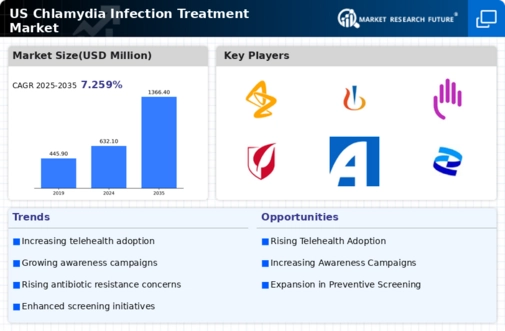Rising Chlamydia Incidence Rates
The chlamydia treatment market is experiencing growth due to the rising incidence rates of chlamydia infections in the United States. According to the Centers for Disease Control and Prevention (CDC), chlamydia is the most commonly reported sexually transmitted infection (STI) in the US, with over 1.8 million cases reported in 2019. This trend indicates a growing need for effective treatment options and increased awareness among healthcare providers and patients. The rising incidence is likely to drive demand for diagnostic tests and treatment solutions, thereby expanding the market. Furthermore, the increasing prevalence of asymptomatic cases necessitates regular screening and treatment, which could further bolster the chlamydia infection-treatment market. As healthcare systems adapt to these trends, the market is poised for continued growth in response to the urgent need for effective management of chlamydia infections.
Increased Awareness and Education
The chlamydia infection-treatment market is benefiting from increased awareness and education regarding sexually transmitted infections. Public health campaigns aimed at educating individuals about the risks and consequences of chlamydia are crucial in promoting testing and treatment. Organizations such as the CDC and various non-profits are actively working to disseminate information about chlamydia, its symptoms, and the importance of regular screening. This heightened awareness is likely to lead to more individuals seeking testing and treatment, thereby expanding the market. Furthermore, educational initiatives targeting high-risk populations, such as young adults and sexually active individuals, are essential for reducing stigma and encouraging proactive health behaviors. As awareness continues to grow, the chlamydia infection-treatment market is expected to thrive, driven by an informed and engaged public.
Government Initiatives and Funding
Government initiatives aimed at combating sexually transmitted infections are playing a crucial role in the chlamydia infection-treatment market. The US government has implemented various programs to promote awareness, prevention, and treatment of STIs, including chlamydia. Funding from the CDC and other public health organizations supports screening programs and educational campaigns, which are essential for reducing the incidence of chlamydia. In 2020, the CDC allocated approximately $160 million for STI prevention and control efforts. Such financial support not only enhances public health initiatives but also stimulates the market by increasing access to testing and treatment options. As these government efforts continue, they are likely to create a more favorable environment for the chlamydia infection-treatment market, encouraging innovation and improving patient outcomes.
Advancements in Diagnostic Technologies
Technological advancements in diagnostic methods are significantly impacting the chlamydia infection-treatment market. The introduction of rapid testing kits and molecular diagnostic techniques has improved the accuracy and speed of chlamydia detection. These innovations allow for timely treatment, which is crucial in preventing complications associated with untreated infections. For instance, nucleic acid amplification tests (NAATs) have become the gold standard for chlamydia testing due to their high sensitivity and specificity. The growing adoption of these advanced diagnostic tools is expected to enhance screening rates and facilitate early intervention, thereby driving the chlamydia infection-treatment market. As healthcare providers increasingly rely on these technologies, the market is likely to witness a surge in demand for effective treatment options that align with improved diagnostic capabilities.
Integration of Preventive Healthcare Services
The integration of preventive healthcare services into routine medical care is emerging as a key driver for the chlamydia infection-treatment market. Healthcare providers are increasingly recognizing the importance of incorporating STI screening and treatment into general health check-ups, particularly for at-risk populations. This shift towards preventive care is supported by guidelines from the CDC, which recommend annual screening for sexually active women under 25 and older women with risk factors. By normalizing STI testing, healthcare systems can facilitate early detection and treatment of chlamydia, ultimately reducing transmission rates. This proactive approach not only enhances patient outcomes but also contributes to the overall growth of the chlamydia infection-treatment market. As preventive healthcare becomes more integrated into standard practice, the demand for effective treatment options is likely to increase.























Leave a Comment